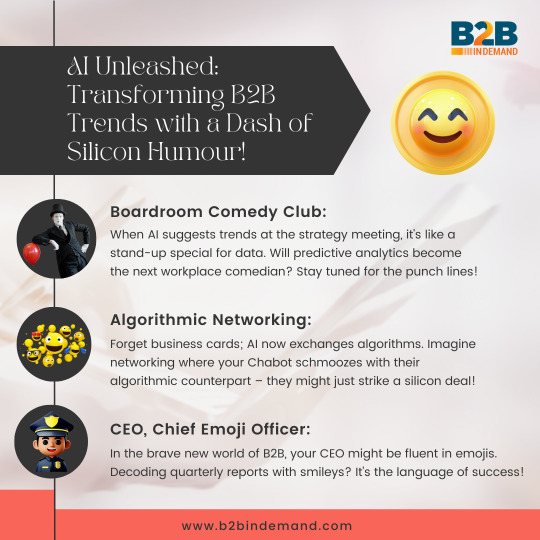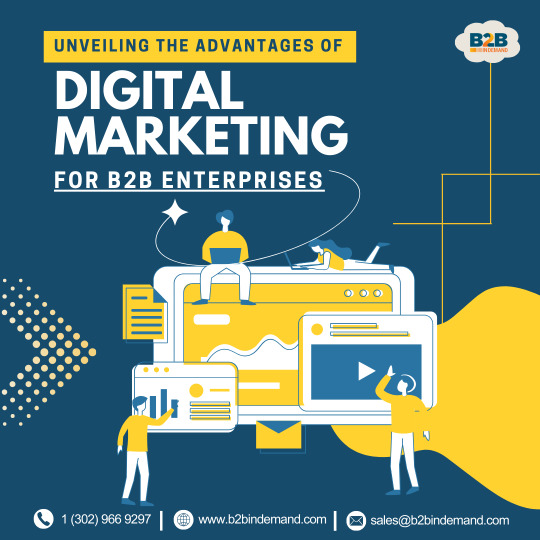#B2bindemand
Explore tagged Tumblr posts
Text
2 notes
·
View notes
Text
AI Unleashed: Transforming B2B Trends with a Dash of Silicon Humour!

#aib2baughs#techtalks#techtrends#siliconhumor#aiunleashed#techinnovation#humorousai#b2bindemand#b2b services#emailmarketing#leadgeneration#b2bsales#b2bmarketing#b2b lead generation#artificial intelligence#funnyclient#funny#funny memes#funny stuff#funny shit#funny post
4 notes
·
View notes
Text
#b2b content marketing trends#b2b content marketing#b2bindemand#content marketing#content syndication#b2bmarketing
2 notes
·
View notes
Text
#Opportunistic Learning#Opportunistic Learning in B2B Marketing#B2B Marketing#b2bmarketing#b2bindemand
2 notes
·
View notes
Text
2 notes
·
View notes
Text
#b2bcontentsyndicationservices#b2bcontentsyndicatio#content syndication#b2bindemand#b2b lead generation#high quality leads#hql
2 notes
·
View notes
Text
#B2B Audience#decisionmaking#b2bindemand#b2b lead generation#b2bmarketing#b2bemailmarketing#b2b buyer's#b2b leads
2 notes
·
View notes
Text
Unveiling the Advantages of Digital Marketing for B2B Enterprises

Description:
In the realm of B2B marketing, digital strategies serve as indispensable assets for driving growth, bolstering visibility, and forging meaningful connections. Let's delve into how digital marketing can empower B2B enterprises to flourish in the current competitive climate.
5 Key Advantages of Digital Marketing for B2B Enterprises:
1. Expanded Reach and Exposure:
Digital marketing presents unparalleled avenues for B2B enterprises to broaden their reach and exposure. Through targeted advertisements, search engine optimization (SEO), and social media campaigns, enterprises can engage their desired audience across diverse digital platforms, amplifying brand recognition and attracting qualified leads.
2. Amplified Lead Generation and Conversion:
By harnessing digital marketing tactics like content creation, email outreach, and pay-per-click (PPC) ads, B2B enterprises can cultivate top-notch leads and drive conversions. With sophisticated targeting options and robust analytics tools, enterprises can fine-tune their campaigns for optimal outcomes and return on investment.
3. Elevated Customer Engagement and Connections:
Digital marketing cultivates meaningful engagement and connections with B2B clientele throughout their purchasing journey. By delivering personalized content, interactive experiences, and an active social media presence, enterprises can nurture leads, address customer queries, and foster enduring trust and loyalty.
4. Data-Driven Insights and Optimization:
Digital marketing empowers enterprises with actionable insights and analytics. Through real-time tracking and measurement of campaign performance, enterprises gain invaluable insights into audience behaviors, preferences, and interactions.
5. Cost-Efficiency and Scalability:
Digital marketing furnishes cost-effective solutions for enterprises across all scales. Compared to conventional marketing methods, digital channels often yield superior returns on investment and lower acquisition costs. Moreover, digital marketing strategies offer remarkable scalability, enabling enterprises to adapt their budgets and initiatives to their objectives and priorities.
Conclusion:
In summation, digital marketing holds myriad advantages for B2B enterprises, from amplified reach and lead generation to heightened customer engagement and data-driven optimization. By embracing digital strategies and leveraging actionable insights, B2B enterprises can realize their marketing aspirations, foster expansion, and stay ahead in the digital-first landscape. Seize the opportunities of digital marketing and unlock the full potential of your B2B enterprise.
#b2bmarketing#seo#search engine optimization#ppc#b2b lead generation#b2bindemand#leadgeneration#b2b services#b2b#b2bsales#emailmarketing#marketingstrategy
4 notes
·
View notes
Text
#b2bindemand#b2b lead generation#b2b marketing#b2bemailmarketing#emailmarketing#b2bmarketing#b2b buyer's
2 notes
·
View notes
Text
#Ethical Data Collection#B2B Marketers#B2B marketing strategies#b2bindemand#emailmarketing#b2bmarketing#b2b marketing
2 notes
·
View notes
Text
2 notes
·
View notes
Text
#b2bdemandgeneration#businessgrowth#demandgensolutions#b2bleads#b2bappointmentgeneration#b2bgrowth#b2bindemand
2 notes
·
View notes
Text
#B2B Content Syndication#content syndication#b2b content marketing trends#b2b content marketing#content marketing#b2bindemand#b2b lead generation
2 notes
·
View notes
Text
🚀 Unlock Success with a Robust B2B Business Strategy Framework!

In the dynamic realm of B2B, a strategic compass is your best ally. Enter the B2B Business Strategy Framework, a guiding light for businesses navigating the intricacies of the market. Here's a glimpse into the power of this framework:
1. Customer-Centric Focus:
🎯 At the core lies a relentless focus on the customer. Understand their pain points, aspirations, and preferences. A customer-centric approach forms the bedrock of every successful B2B strategy.
2. Data-Driven Decision Making:
📊 Harness the power of data. The framework advocates for informed decisions backed by robust data analytics. From market trends to customer behavior, data unveils insights that shape strategic moves.
3. Agile Adaptability:
🔄 In a fast-paced environment, agility is non-negotiable. The framework encourages businesses to be nimble, adapting swiftly to market changes and staying ahead in the game.
4. Integrated Marketing Excellence:
🌐 Seamless integration of marketing efforts is a hallmark. From digital channels to traditional methods, the framework emphasizes a cohesive approach that amplifies the impact of every marketing initiative.
5. Innovation at the Core:
🚀 Innovation isn't a buzzword; it's a way of business. The framework promotes a culture of innovation, pushing boundaries to create products, services, and experiences that set you apart.
6. Collaboration Amplified:
👥 Collaboration is a force multiplier. The framework encourages strategic partnerships, fostering collaborative ecosystems that drive mutual growth and innovation.
7. Performance Measurement Metrics:
📈 What gets measured gets managed. The framework advocates for robust performance metrics. From KPIs to ROI, businesses are equipped to track, analyse, and refine their strategies continually.
8. Risk Mitigation Strategies:
🛡️ Risk is inevitable, but mitigation is strategic. The framework guides businesses in identifying potential risks and developing proactive strategies to navigate challenges effectively.
9. Brand Authenticity and Trust:
🌟 Beyond products and services, the framework places brand authenticity on a pedestal. Building trust is not just a goal; it's a strategic imperative for sustainable growth.
10. Long-Term Vision and Adaptation:
🔮 Success is not just about the present; it's about laying a foundation for the future. The framework encourages businesses to craft a vision that stands the test of time while remaining adaptable to evolving landscapes.
Embrace the B2B Business Strategy Framework as your compass, steering your business towards resilience, innovation, and sustained success. Ready to elevate your strategy game? 🚀✨
#b2b business#b2b lead generation#b2bmarketing#power of data#B2B Business Strategy#b2bindemand#emailmarketing#marketingstrategy#b2b services
2 notes
·
View notes
Text
2 notes
·
View notes
Text
2 notes
·
View notes